Fasting Mistakes: Top 7 Things That Sabotage a Fast
Fasting is one of the most powerful yet non-expensive healing tools you can use. Just by not eating for longer periods of time, you can take advantage of things like accelerated weight loss, improved mental function, increased cellular repair, drastic anti-inflammatory states, and a lot more than I will go into here (check out this article for more on fasting benefits). If you are making certain fasting mistakes, you may not have the best experience. Here we will cover the most common fasting mistakes and easy solutions.
Because the potential for healing is so great during fasting, I want to make sure you are armed with the information you need to take advantage. Whether you are fasting for disease healing or disease prevention, the tips below are critical for your success.
Be sure to check out my FREE webinar where I go through the 7 BIGGEST reasons why fasting may not work for someone (which could be you!) and what you can do to have success. I will also be going through my #1 trick that works every time with fasting! You can register here.
Signs of Fasting Mistakes
There are certain signs to look for to gauge if you are on the right track with your fasting protocol or not. Generally, once you have adapted to fasting – you should feel light, full of energy, mentally sharp, and not all that hungry.
Each person brings to fasting their unique physiology, experience, and health challenges that can highlight unique hurdles in the process. Luckily, it usually comes down to just a few mistakes that are easy to fix. The following are signs that you are making one of these common fasting mistakes.

Very Low Energy & Brain Fog
If you are new to fasting, chances are you will experience at least a short period of low energy. This is usually due to a drop in blood sugar that precedes the body shifting over into ketosis (fat burning). This should go away with time.
However, if you experience low energy and brain fog after doing intermittent fasting for several weeks or are 2-3 days into a prolonged fast – you are likely making one of the fasting mistakes listed below.
In fact, most people report that they feel their most mentally sharp and energized while fasting!
Finally, keep in mind that fasting is not for everyone (especially multi-day fasting). The graphic below depicts those who should not engage in longer fasts – but may still do just fine with an intermittent fasting schedule.
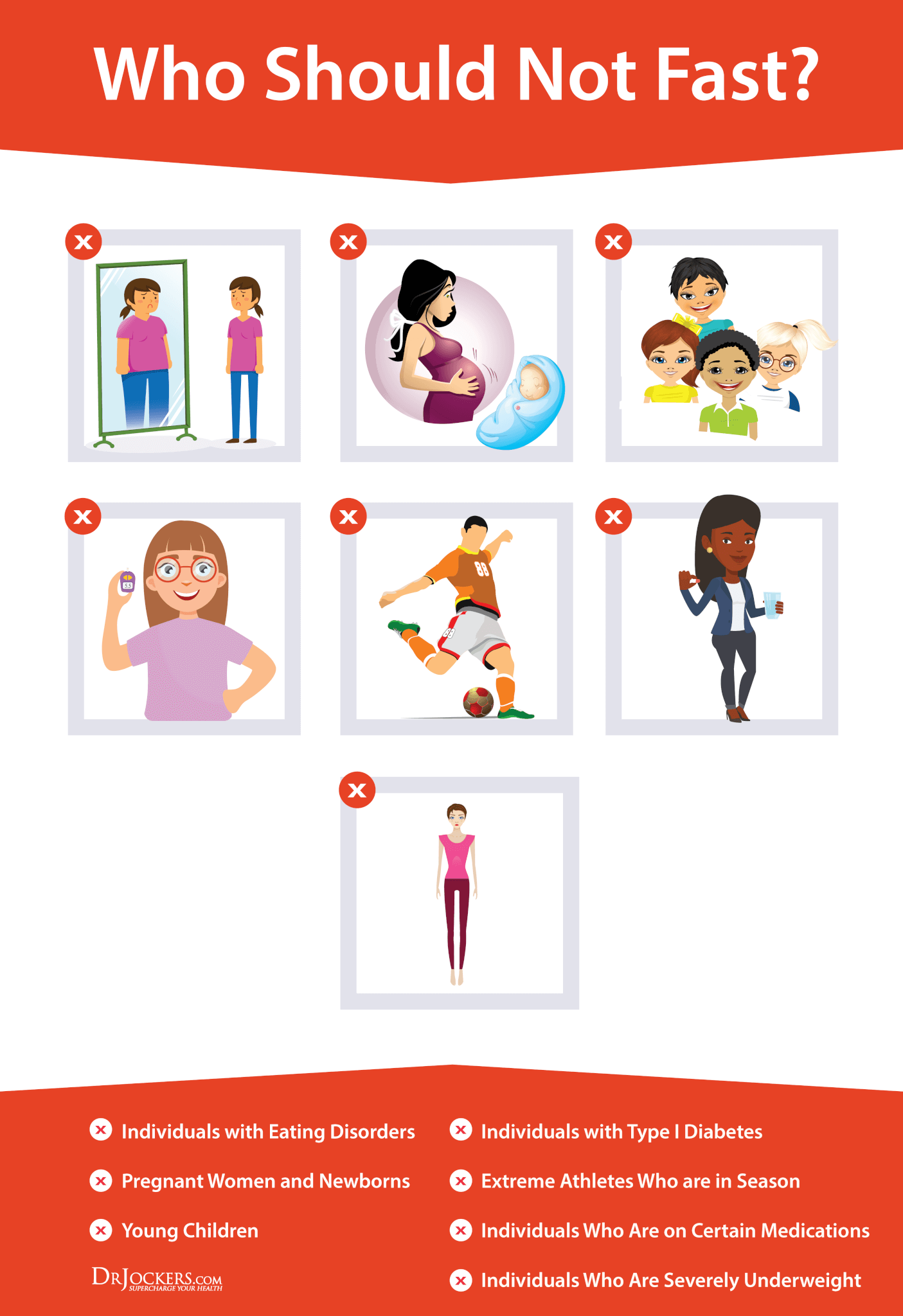
Persistent Cravings
Similar to having low energy and brain fog, cravings are usually a sign of low blood sugar before the body shifts into fat burning. Another thing to keep in mind is that you may also be facing a psychological attachment to food. As time goes on, cravings due to either cause should subside as the body gets more efficient at burning fat and you break your subconscious drive to eat every few hours.
Once adapted to fasting, cravings should very rarely occur unless one of the fasting mistakes below is being made. If you are in the beginning stages of a prolonged fast and feeling hungry, keep going!
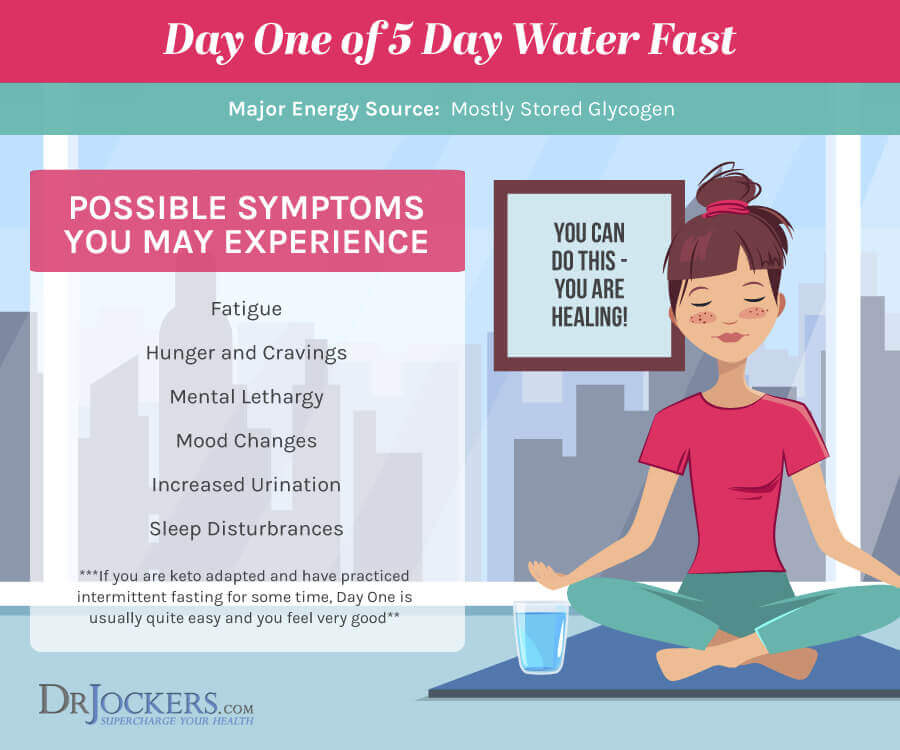
Dizziness
Dizziness when standing is a common yet unpleasant side effect that can be experienced with fasting. This can occur for a number of reasons like low blood sugar, poor hydration, sedentary behavior, or not enough salts.
Again, this sensation should subside rather quickly. If you experience debilitating disorientation while fasting, you will want to consider refeeding. Check for the signs illustrated below.
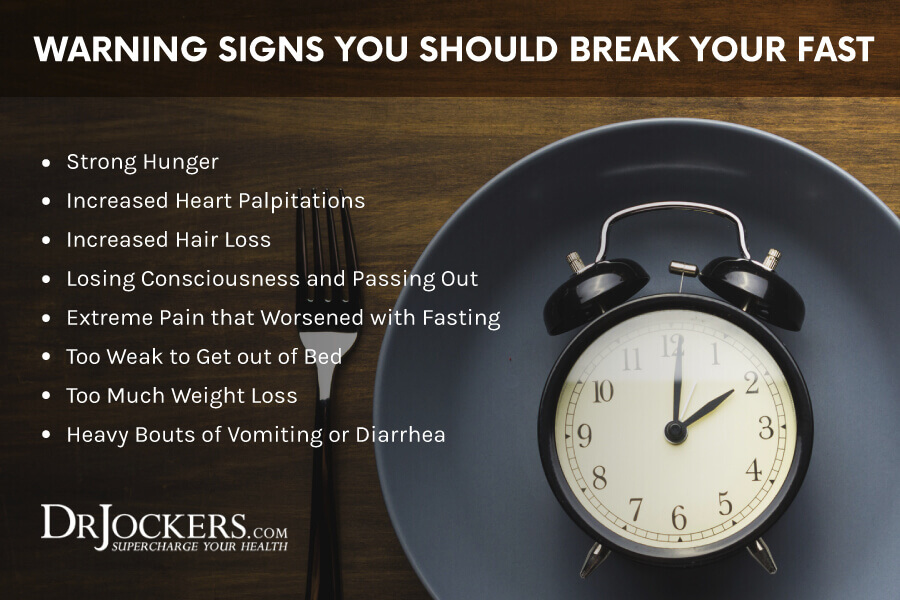
Headaches
Headaches can be caused by a number of things when fasting. These include:
- Dehydration
- Poor Salt Intake
- Rapid Release of Toxins stored in fat tissues
- Temporary Hypoglycemia experienced before shifting into ketosis
These will all be addressed in the fasting mistakes section below. Remember, fasting should promote mental energy and clarity.
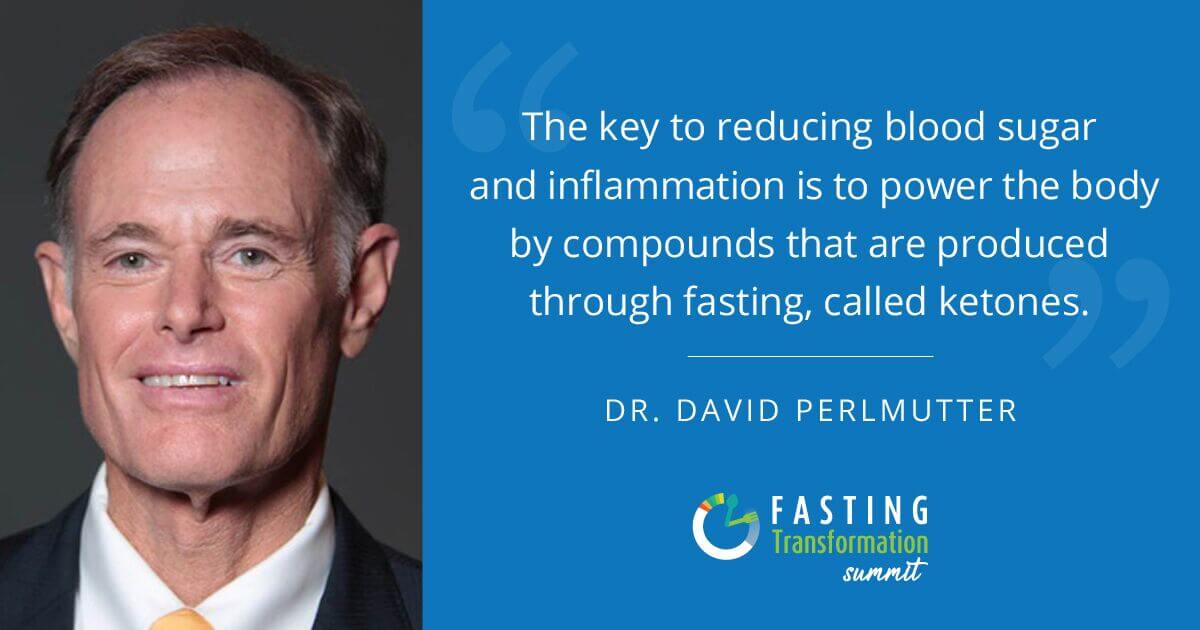
Constipation
Constipation is not only uncomfortable but can also lead to other fasting side effects. When your bowels are not moving regularly, this allows excess fermentation to occur in the colon which can promote an overgrowth of unwanted bacteria.
This growth of bacteria can also promote the formation of toxic byproducts. Ultimately, these byproducts will make their way into the bloodstream and affect your body in various ways. In fact, many cognitive impairment symptoms (like brain fog) can be caused by this simple phenomenon.
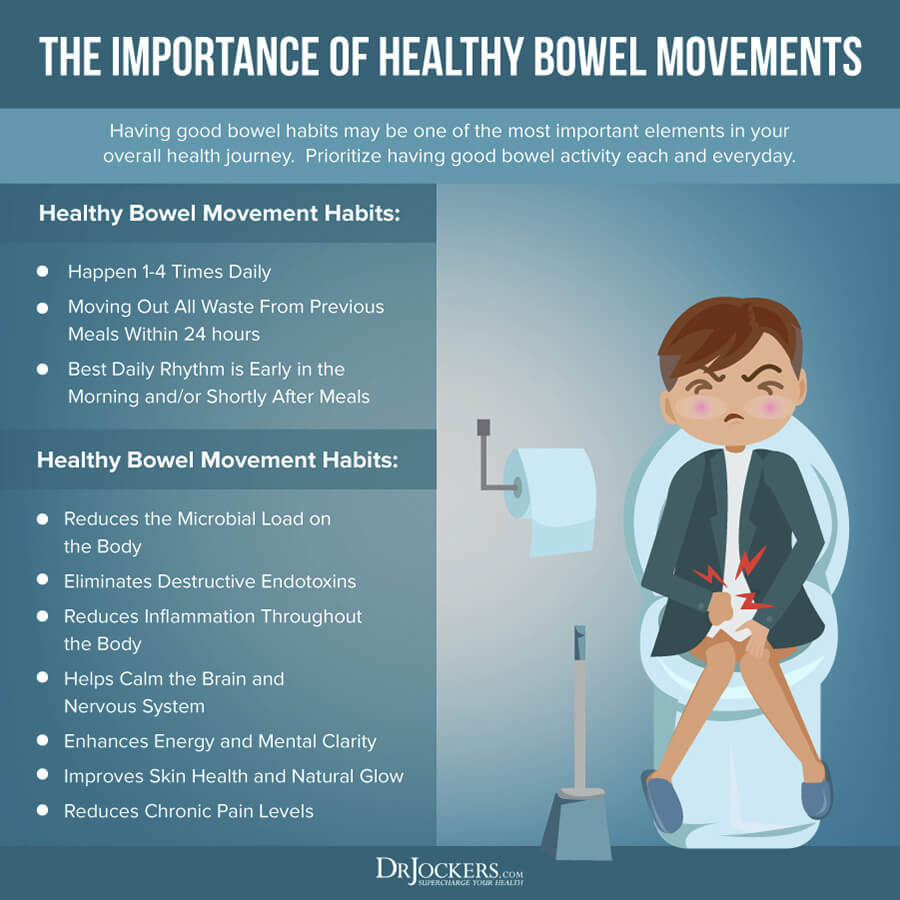
Not Losing Excess Fat
Fasting should promote accelerated fat-burning when done correctly. If you hit a plateau in your weight loss, make sure you are not making one of the fasting mistakes below. It could be a simple fix! I will be going over exactly what to do in my free webinar here
Top 7 Fasting Mistakes
Now you know what to look out for with some of the major signs your body is not adapting to fasting well. So if you are struggling with your fasting routine or if you are just doing your research before beginning your first fast, make sure you don’t make these fasting mistakes!
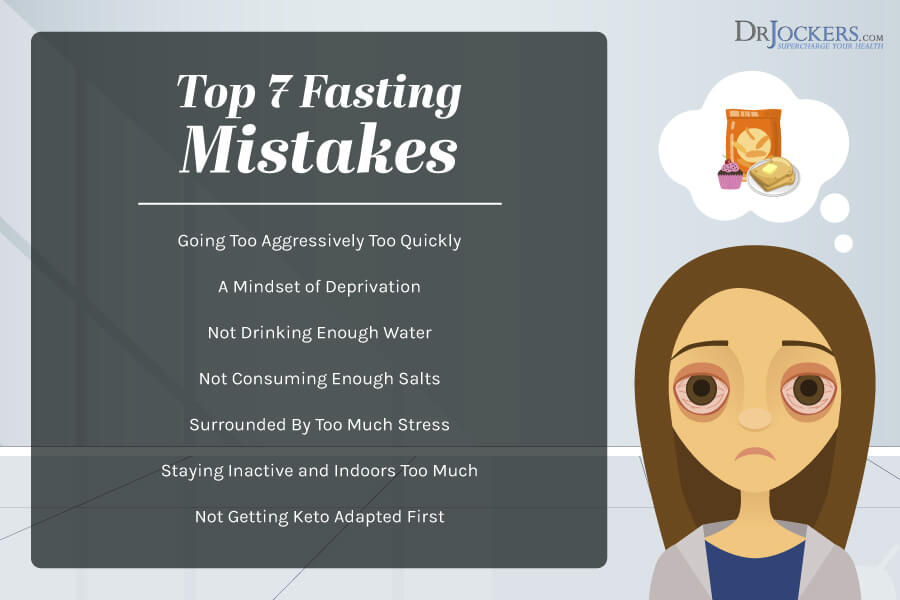
Going Too Aggressive Too Quickly
It takes time to become adapted to fasting. Teaching your body to thrive without food is like beginning a new exercise program. You have to understand your current fitness level and scale up as you become stronger. Fasting is no different. Start slow, get a feeling for the routine, then scale up as it gets easier.
While your body has grown accustomed to three square meals a day (or more.. plus snacks!), it now has to learn how to pull from stored energy already within the body. First, you will burn through stored sugar in the liver known as glycogen. Once this is depleted, your body will resort to burning body fat.
The more you practice fasting, the more efficient your body will be at shifting between the two. If you rush it, you will likely deal with unpleasant low blood sugar symptoms that occur between this metabolic shift.
While some people have no issue jumping into a multiple-day fast right away, most people will need to start with a short period and work up to a longer fast. The strategies below will help you scale up.
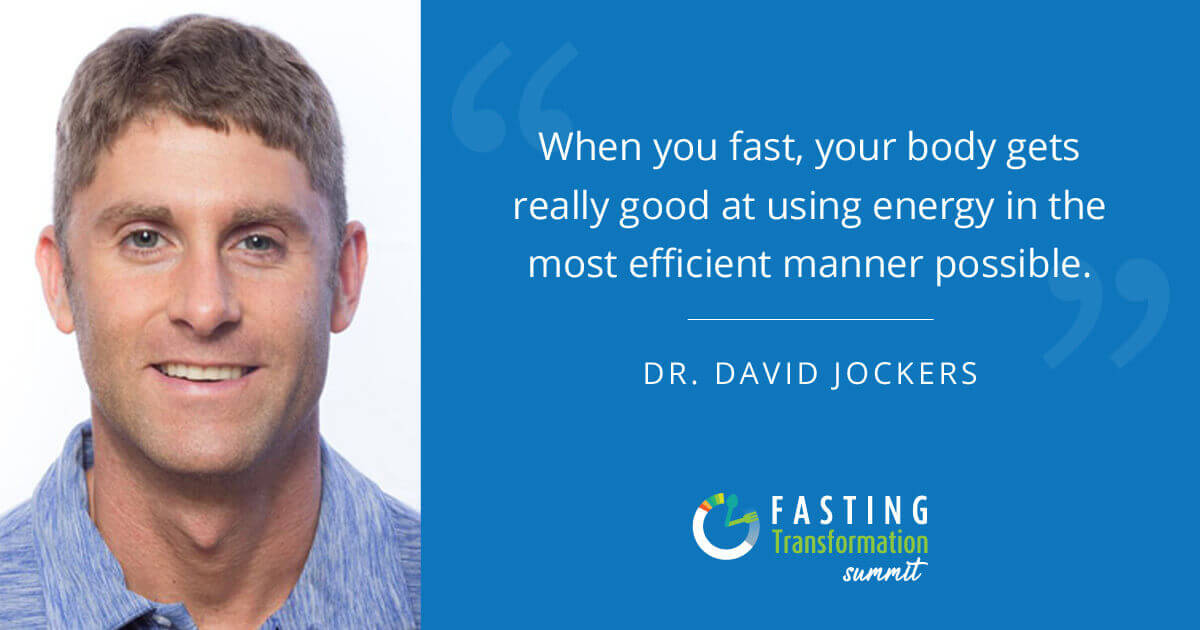
Solution: Gradually Increase Intermittent Fasting Window
Instead of jumping immediately into a 2-3 day water fast, first, start by eating your meals in a 12-hour window. Once this becomes easy, reduce your eating window to 10 hours. Continue this pattern by decreasing your eating window by two hours every 1-2 weeks. Make sure to only consume non-caloric beverages during your fasting window such as purified water, teas, and black coffee.
A note on coffee: caffeine intake in a fasted state actually increases your ability to burn fat (1)! Because of this, caffeine can be used strategically to increase ketone levels and subdue hunger.
A good fasting progression to follow would look something like this:
Milestone 1: Comfortably consume all meals within a 6-8 hour window for at least a week. Throwing in an hour workout window during the fasting period can be an excellent way to accelerate fat-burning.
Milestone 2: Complete a single 24-hour fast in a week (Example, Saturday 6 PM- Sunday 6 PM – breaking fast with Sunday night dinner)
Milestone 3: Complete a 24-hour fast with a fasted workout 2-3 hours before your refeed. Immediately follow this with another 24-hour fast.
Milestone 4: Begin to Experiment with 48 hour or longer fasts and make sure you are not making any of the other fasting mistakes below!
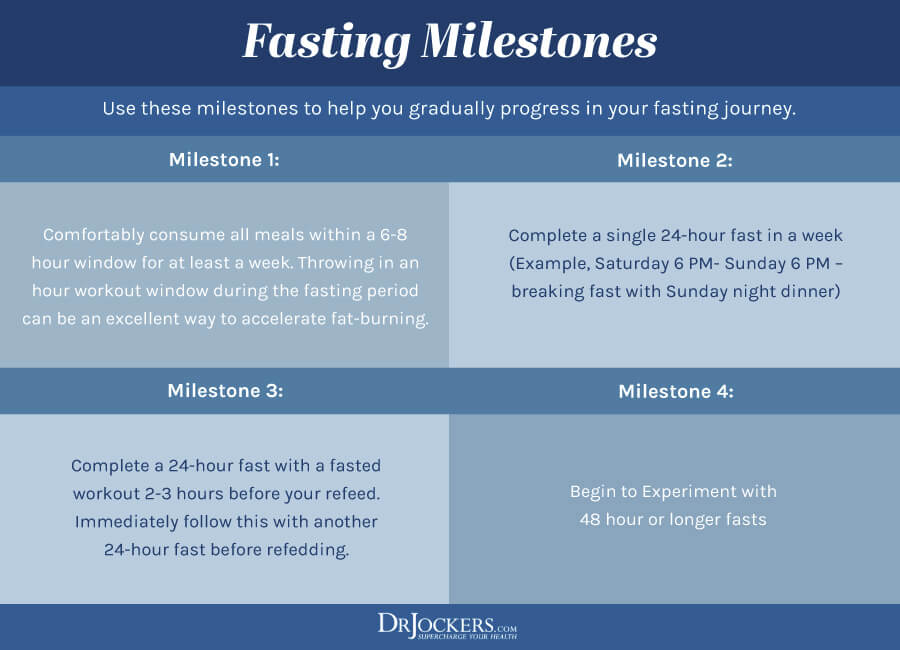
Solution: Fat Fast
You may have heard of people putting butter in their coffee in the morning as a new way to start their day. When done correctly, this strategy can be excellent for preparing the body to tap into fat stores while fasting.
As we discussed already, caffeine upregulates fat burning almost immediately after drinking it. When you combine coffee with healthy fats like butter, coconut oil, or MCT oil – you can teach your body to burn fat without having to do a strict fast.
Instead of jumping right into a longer fasting window, try starting your day with one of these drink recipes:
Coconut Dandelion “Coffee” (Caffeine Free)
Simply drink one of these beverages in the morning and wait until about noon to consume your first solid food meal of the day. After a few weeks, your body should be more prepared to take on a strict fast.
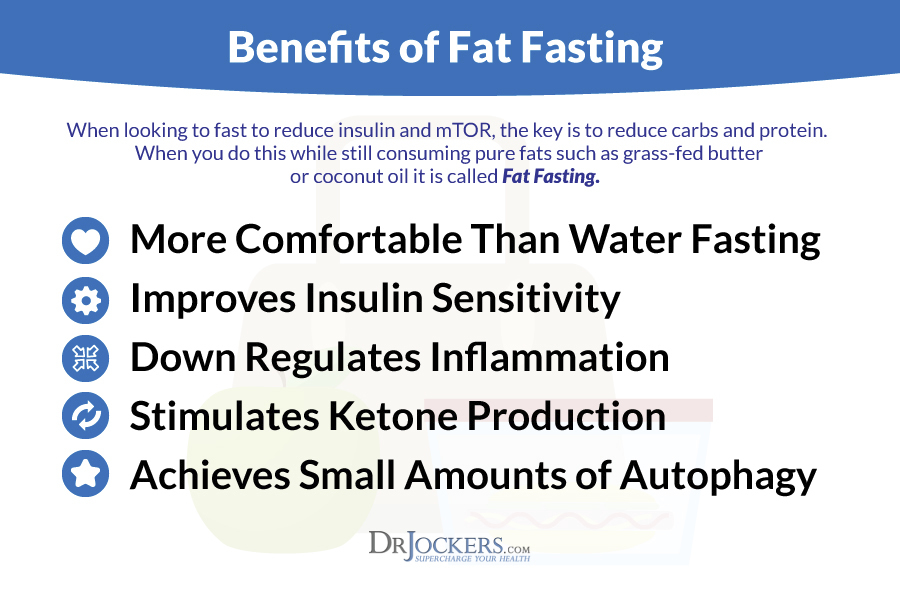
Mistake #2: Having a Mindset of Deprivation
Everyone loves to eat and it is really common to feel deprived as you begin fasting. However, if you focus on the “deprivation” element of the fast and not the healing benefits, you will convince yourself you need to eat and you will break the fast.
Your mindset is so important to your success in anything you do in life. When I begin to feel deprived or have a desire to eat food, I try to reframe my mind to focus on the remarkable mental, emotional and physical healing that is happening in my body right at that moment. I also remind myself that I am going to be ok, that I am not truly being deprived and that I will feel better later.

Solution: Be a Part of a Fasting Community
One of the most important things I have found for most people as they begin a fast is to not feel isolated. Doing a fast with your spouse or significant other, with a friend or group of friends or an online community is really helpful. When you do the fast with others you don’t feel alone and you have a level of accountability.
If you don’t have anyone in your personal life who is interested in practicing a fasting lifestyle or doing an extended fast with you than I would suggest joining our Fasting Transformation Experience facebook group here.
Mistake #3: Not Drinking Enough Water
Staying hydrated while fasting is critical. This requires both adequate water and adequate minerals such as sodium, potassium, and magnesium.
Without proper hydration, you will likely feel much more tired, dizzy, and potentially constipated while fasting.
In fact, this is likely one of the most common fasting mistakes. Keep some water handy with a bit of sea salt in it to sip on throughout your fast. Continue reading for some ideas on how to make your own electrolyte solution for fasting.

Solution: Use an App or Alarm to Remind You
Many apps exist on all phone platforms that serve as a reminder to drink water. Alternatively, you can simply set a repeating alarm on your phone to remind you to drink a bit of water every 1-2 hours.
Solution: Super Hydrate in the Morning
Another great way to make sure you are getting enough water is to just start your day off with what I would call super-hydration.
First thing in the morning, make it your goal to consume 32-48 ounces of filtered water within 1-2 hours of waking up. If you are going to take this approach, you may want to make it a point to also consume some minerals so add in a sprinkle a high quality sea salt or pink salt.
Hack: Carbonated Water
If you struggle with food cravings throughout the day, drinking a bit of carbonated water can be great for settling them. Many people swear by this method when they get hungry during a fast. I will be going over this and more on my free webinar.
Mistake #4: Not Consuming Enough Salts
As I have touched on already, staying hydrated depends upon both water and mineral salts (electrolytes). One of the primary roles of water in the body is to help conduct electrical impulses throughout the nervous system. Without electrolytes, you lose some of this conductive power.
If you think about it, fasting is supposed to be a time of accelerated healing for the body. If you are fasting, but inhibiting your brain’s ability to communicate with your organs – you may be sabotaging yourself!
In addition to this, not getting enough salts will contribute to feelings of lightheadedness, fatigue, muscle cramps, and constipation. Of all fasting mistakes, dehydration is one of the most important to avoid.
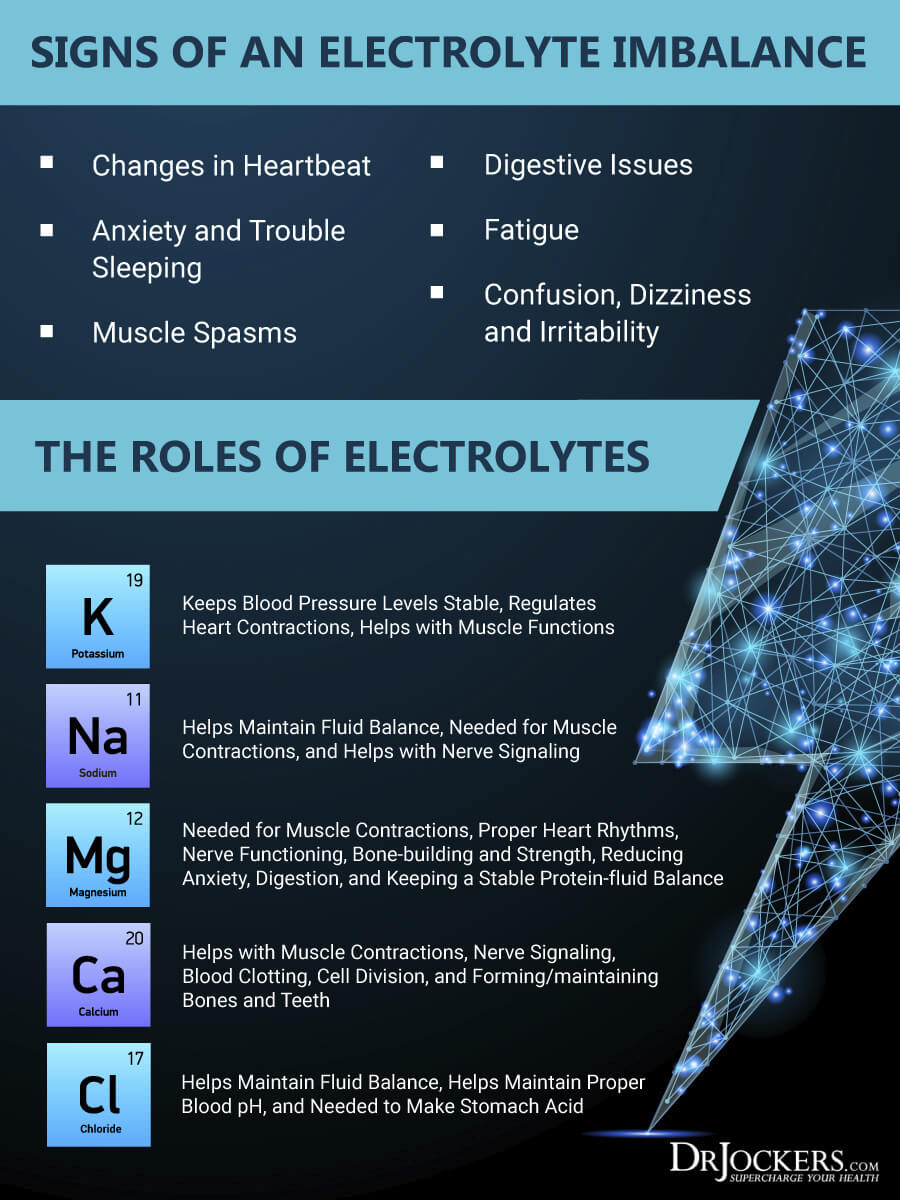
Solution: Get Your Salts In!
Getting more salts is relatively easy to do. Depending on your current fasting schedule, this is what I would recommend.
For an Intermittent Fasting Schedule:
- Add salt liberally to meals
- Add a pinch of Himalayan or Celtic salt to your water
- Consume mineral-rich foods like salted leafy greens, seaweeds, and bone broths
For an Extended Fasting Schedule:
- Use an electrolyte solution like Energy Charge while fasting
- Combine the following to 64 ounces of water and sip during the day
- ½ Tsp of Himalayan or Celtic Salt
- 1 Tsp of Sodium Bicarbonate (Baking Soda)
- 1 Tsp of Potassium Chloride
- ½ Tsp of Magnesium Sulfate (Food Grade Epsom salts)
Mistake #5: Too Much Stress
Really high amounts of stress can be a fasting killer. While fasting, your body should be tapping into stored body fat and preserving muscle tissue. If you are highly stressed, you will be excreting higher amounts of the stress hormone cortisol. This can be an issue because cortisol is catabolic – meaning it promotes the breakdown of body tissues.
In many cases, chronically elevated cortisol will lead to the breakdown of muscle tissue (2). Optimally, we want to break down fat tissue instead. If you are someone who is highly stressed, you may want to take extra measures to ensure your fasting period is relaxing or utilize the next strategy.

Solution: Use Cortisol Mitigating Herbs & Techniques
An Ideal scenario for highly stressed individuals may be to actually take a few days off work and spend some time in nature during their fasting period. This is obviously not an option for everyone. Here are some other tips to help control stress levels while fasting:
- Utilize deep breathing and positive visualization frequently throughout the day
- Take Epsom salt baths each night before bed
- Utilize herbs found in Cortisol Defense to keep cortisol levels from increasing too much during your fast
Read more about taking control of your stress in this article.
Mistake #6: Staying Inactive and Indoors Too Much
While you generally will want to take it a little easier than normal while fasting, you don’t want to become a complete couch potato. Generally, people feel much better if they can get some movement in during the day.
If you sit inside all day and get little movement, you will tend to start feeling cold and groggy. This is one of the most common fasting mistakes I see people make because they think since they aren’t eating food, they need to just rest all day.
Exercise is a great way to upregulate fat burning, boost circulation, and improve your fast. Getting some sunlight and grounding will help lower inflammation and improve the healing process while fasting as well. Another bonus for grounding is that it actually helps lower stress, which as you now know, will help ensure you are burning fat instead of breaking down muscle tissues (3)!
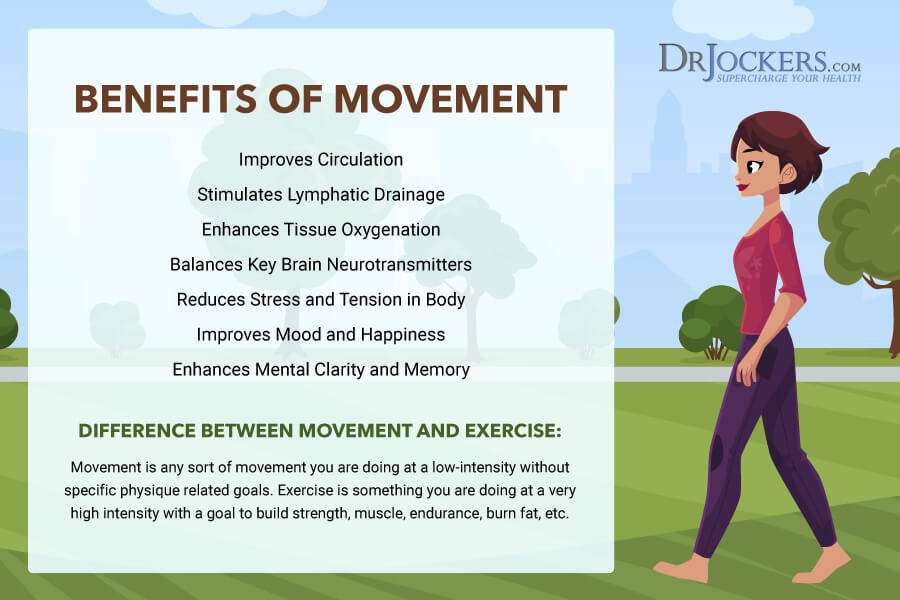
Solution: Morning Activity and Cold
Starting the day with a light aerobic activity such as walking can be a great way to get the lymphatic system moving. Coupled with a brief cold shower or at least 30 seconds of cold exposure at the end of your shower increases this benefit even further.
During an extended fast, your body will break down and recycle many cellular components, many of which will be present in the lymphatic fluid. The lymphatic fluid relies on muscular contractions to circulate properly so getting movement throughout the day is key!

Solution: Take Active Work Breaks
If your daily schedule puts you in a stationary position for most of the day, take active breaks as often as possible. Walk around the office or the neighborhood if you work at home. Do anything you can to keep active without overstressing your body. The more you can do outside, the better.
The benefits of sunlight, fresh air, and putting your bare feet on the ground are priceless. I will discuss this and more on my free webinar
Mistake #7: Not Getting Keto Adapted First
As was touched upon already, when you get into a deep fasting state – your body will be burning stored fats as a primary energy source. One of the big fasting mistakes I see over and over again is people trying to go from a carb-dominant meal plan, straight into fasting. If you have never fasted or intentionally put your body in a state of ketosis, then fasting will likely make you feel a bit off at first.
Getting your body adapted to a state of ketosis will make fasting much easier. There are two ways of doing this that I recommend: following a ketogenic diet or using an exogenous source of ketones.
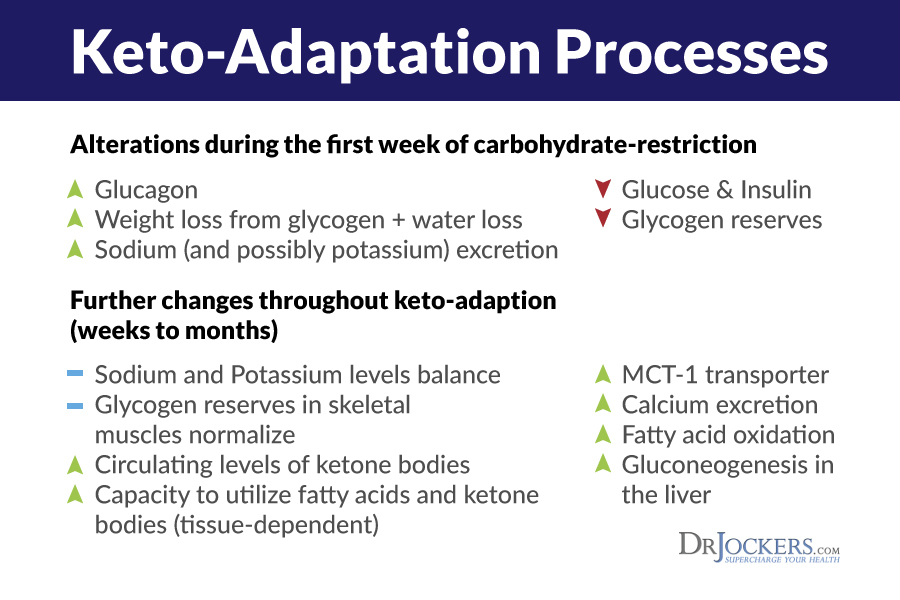
Solution: Keto Metabolic Makeover
One of the best ways to prepare your body for a fast is to first teach it to burn fats really well. If you are a high-level athlete then you may already be a good fat burner. If you are the average person that has had carbs with every meal since birth, you will want to try this.
A Keto Metabolic Makeover is a month period in which you reduce your carb intake and increase your healthy fat intake. When carbs are scarce and fats are abundant, your body will shift to burning fat as a primary energy source. This is exactly what happens when you fast. In this scenario, however, you are easing your body into the process.
Once you have taught your body to burn fats effectively, you are ready to take on a longer fast! Read about how to implement this strategy in this article.
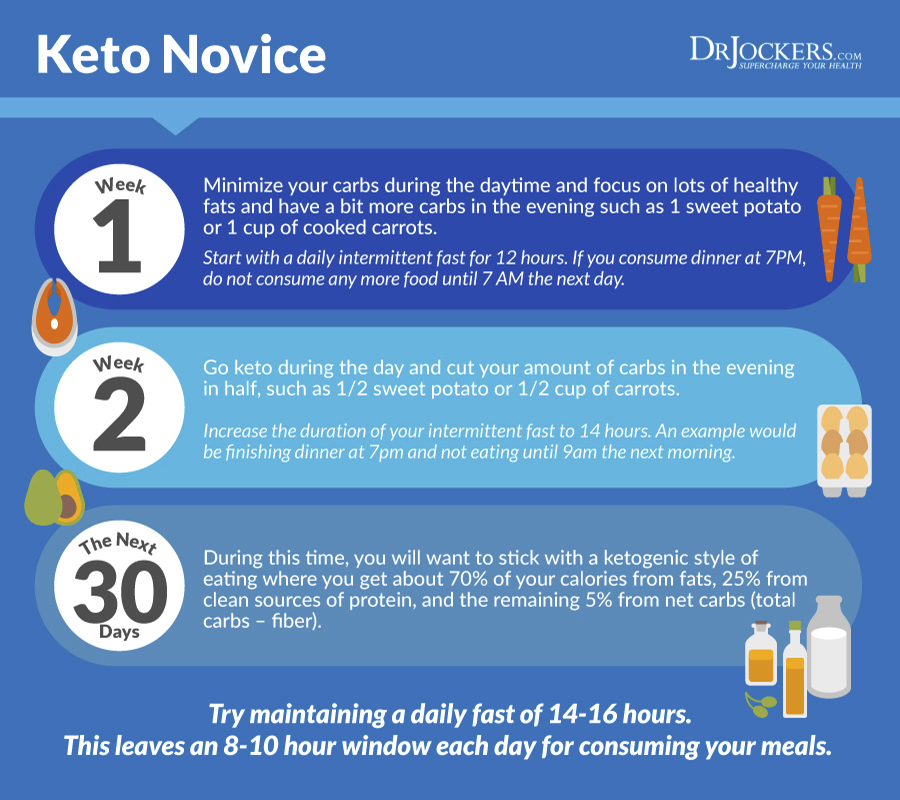
Using Exogenous Ketones
Exogenous ketones are a supplement that can be used to supply the body with a source of ketones that require almost no processing by the digestive tract and liver. This makes them great not only for helping someone get into ketosis, but also as a quick energy source and performance enhancer for brain and body.
By getting ketones in the system before the body is producing them endogenously gets your brain and body the ketogenic fuel it needs to thrive in a low blood sugar environment. This is a very helpful tool to feel good while you first are working to get keto adapted or are first setting out on an intermittent fasting lifestyle.
The brand I use is Keto Edge, which has exogenous ketones, electrolytes and the adaptogenic herb ginseng to help your body deal with stress better, support healthy brain function and enhance your immune system. Simply take a scoop in water at any time that you are feeling hypoglycemic responses coming on.

Summary and Bonus Fasting Tip
Above are the top fasting mistakes many people make when they decide to start a fasting-focused lifestyle. While engaging in longer fasts will usually come along with a bit of mental determination, the tips above will help ensure your fast goes by as smoothly as possible while providing full benefits.
Also, don’t forget to break your fasts according to the length of time you went without food. Refer to the graphic below for some tips on breaking a fast and check out this article for more detailed info.
Below is one more tip that many find helpful when engaging in a longer fast.
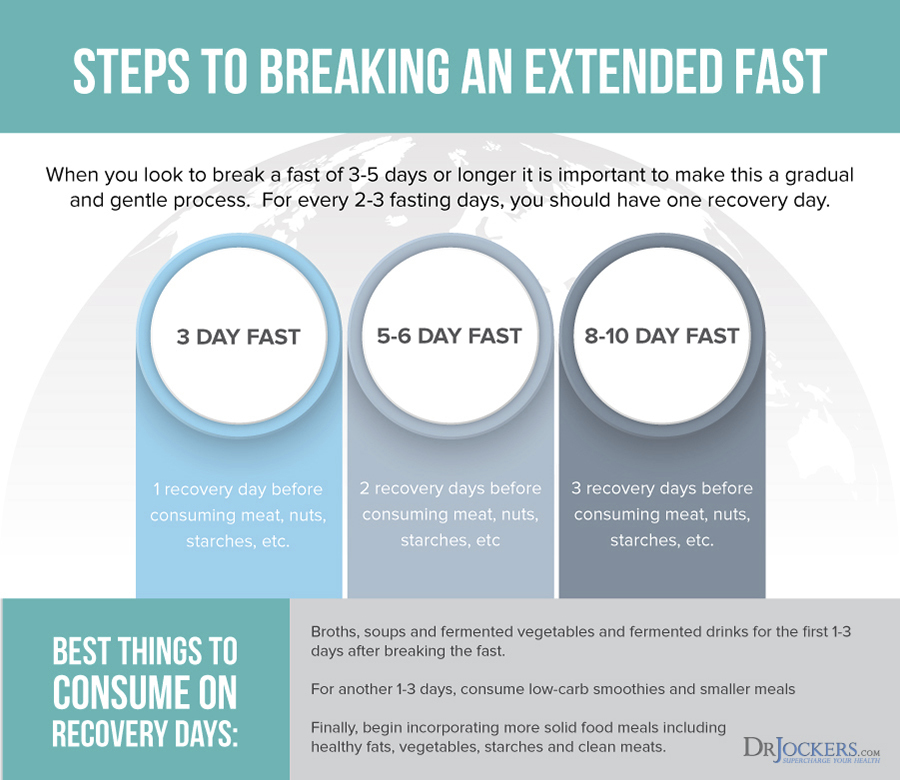
Clear Your Bowels
As we discussed, having excess waste in your bowels for prolonged periods is not a good thing. Especially if you are fasting for digestive health, this is one of the most important fasting mistakes to avoid. Something that many people find useful going into a fast is doing some kind of colon cleanse.
Consider these 2 methods to get things moving before your fast for maximum benefits:
Coffee Enemas can be great for clearing the bowels, stimulating the liver, and up regulating antioxidant systems in preparation for the cellular cleanup that occurs while fasting. Perform one the morning of day 1 of your fast to ensure all waste is clear from your colon. You can learn more about how to do these in this article.
Oxy-Powder is a non-invasive and powerful way to clear stagnant waste in the bowels in preparation for a fast. This oxygen-based colon cleanser can be used several days leading up to an extended fast or the night before. Simply take a few capsules and this gentle yet powerful cleanser dissolves impacted fecal matter throughout the intestines which your body eliminates naturally. Find it here.





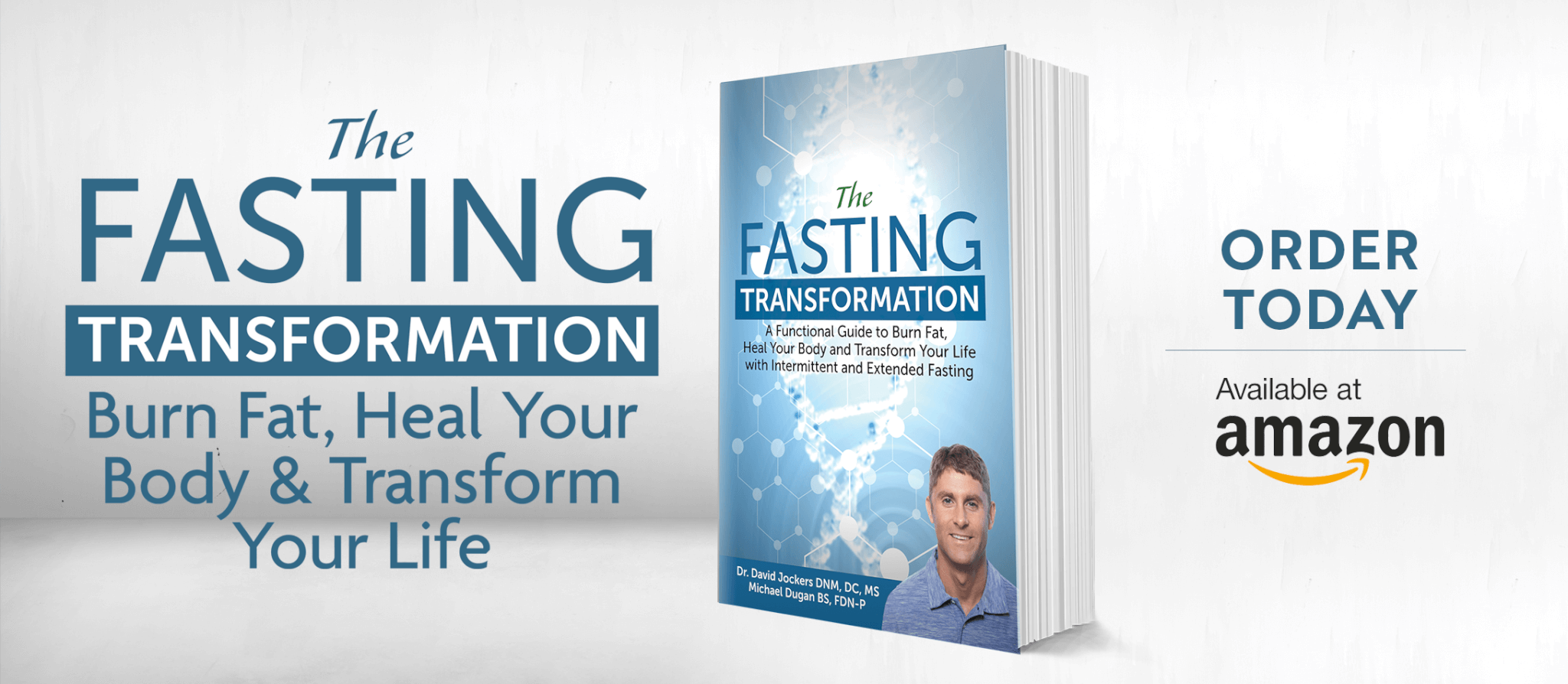


Fantastic article! Very in depth and helpful information including the recommended products that can assist. For me just starting out since the fasting seminar the other week, this is really informative and useful information. I’ll be bookmarking it and coming back to it as a reference for sure, as there is a lot of good info to work through. Thanks!
Great to hear that Jen!!
Thank you!!💖
Yes for sure!!
You have blessed me so much. I’m telling everyone about you and what I’ve learned from the fasting summit. I am doing IF for almost 2 months now and I never thought I’d be able to do this. The 24 hour fasts are easier than I thought they would be – I worked up to them – but once I refeed (keto) I feel pretty crappy. Not sure if this is normal.
So great to hear that Nicole! Perhaps you are having a food sensitivity to something you are consuming or you may need some digestive enzymes and stomach acid support to help you when you eat your meal! Blessings!
Really great information- Thankyou! I just did my first 24 hour fast yesterday- strangely I didn’t actually feel hungry at all! I wanted to eat sometimes but I was not actually hungry.
Today I feel very energetic – fine really .
Do you have any advice for vegetarians please? Obviously bone broth is out ! Thanks!
That is great! Here are ways to break your fast: https://drjockers.com/extended-fasting/
This is deeply valuable information and vibrates with such positive energy. Thank you for your passion and effort in putting this together!
As a holistic practitioner myself, it’s such a blessing to read through new things I haven’t studied or experienced personally. Looking forward to the webinar, Dr. Jockers! Blessings to you!
In love and light,
Bethany
Hey Bethany, Thank you so much for your kind words and encouragement! Be blessed!
Dear Dr. Jockers,
As a person who has practiced fasting for 48 years, and learned how to do it from someone who ran fasting institutes and was a student of Dr. Herbert Shelton, I found your information both detailed in ways I hadn’t known about before, but also very light on addressing what people‘s diets are before they begin exploring fasting. People on red-meat, fast-food diets should modify their diets for a good period before beginning a fast, if they don’t want to get quite sick while they are fasting. This applies also to people who are on a lot of medications, not to mention those with heavy exposure to toxic chemicals in their environments. Unfortunately, we all carry a toxic-chemical load, no matter how cleanly we we try to live, given the ubiquitousness of toxic chemicals in our environment.
I can say that fasting has been the greatest healing and renewal practice I have ever tried! After the first three days on a filtered water fast, the hunger is gone, my brain clears, my reflexes get faster, and my hair and skin become noticeably healthier. Of course, during a fast, muscular energy is lower, because the body has shut down the digestive process process in order to go full-bore into elimination and renewal. I have been a vegan/vegetarian all of those 48 years, and my diet currently consists mostly in raw organic vegetables, fruits, nuts and salads, with cooked or sprouted legumes, very little dairy or eggs, and very few grains, nightshades, or root vegetables, and of course no fast foods. I’ve not been in a hospital for 48 years, nor have I taken any medications except anaesthetics for dental work. I’m also the mother of three adult children and seven grandchildren and am still employed at the age of 78. Yes! Fasting (and what one eats when not fasting)!
Thank you for your work!
Hey Terese, That is great to hear! Thank you for sharing. Yes, I agree. We have other articles like this one that offers strategies on preparing for a fast. Blessings!
I can only echo the other comments on detail and thoroughness.
Most of my fasting has been multiple-day exercises, prompted by Bruce Fife’s book on coconut water. In that sort of fasting (which obviously is not fasting) the body’s responses are different, especially regarding electrolytes. Of course sodium is still an issue but digestion and lethargy typically are not. That said, we’re talking about opening a ton of coconuts and that can be pricey, time consuming, and not palatable after about the ten one.
But I digress — I’ve found very little sound direction on breaking fasts and so that segment here was incredibly helpful. And, of course, I’d like to avoid fasting mistakes,
As for coffee, I find it far too stimulating and it causes me concern for my adrenals, In past fastings even the light caffeine in green tea has resulted in a very quick headache, So for my physiology caffeine feels invasive and counter productive to a cleansing mission.
Thanks for sharing this Gordon!
I have been an ardent advocate for a good living but the steps and physiology of fasting wasn’t well understood. I am going to incorporate these into my next fasting regime.
Glad to hear this!